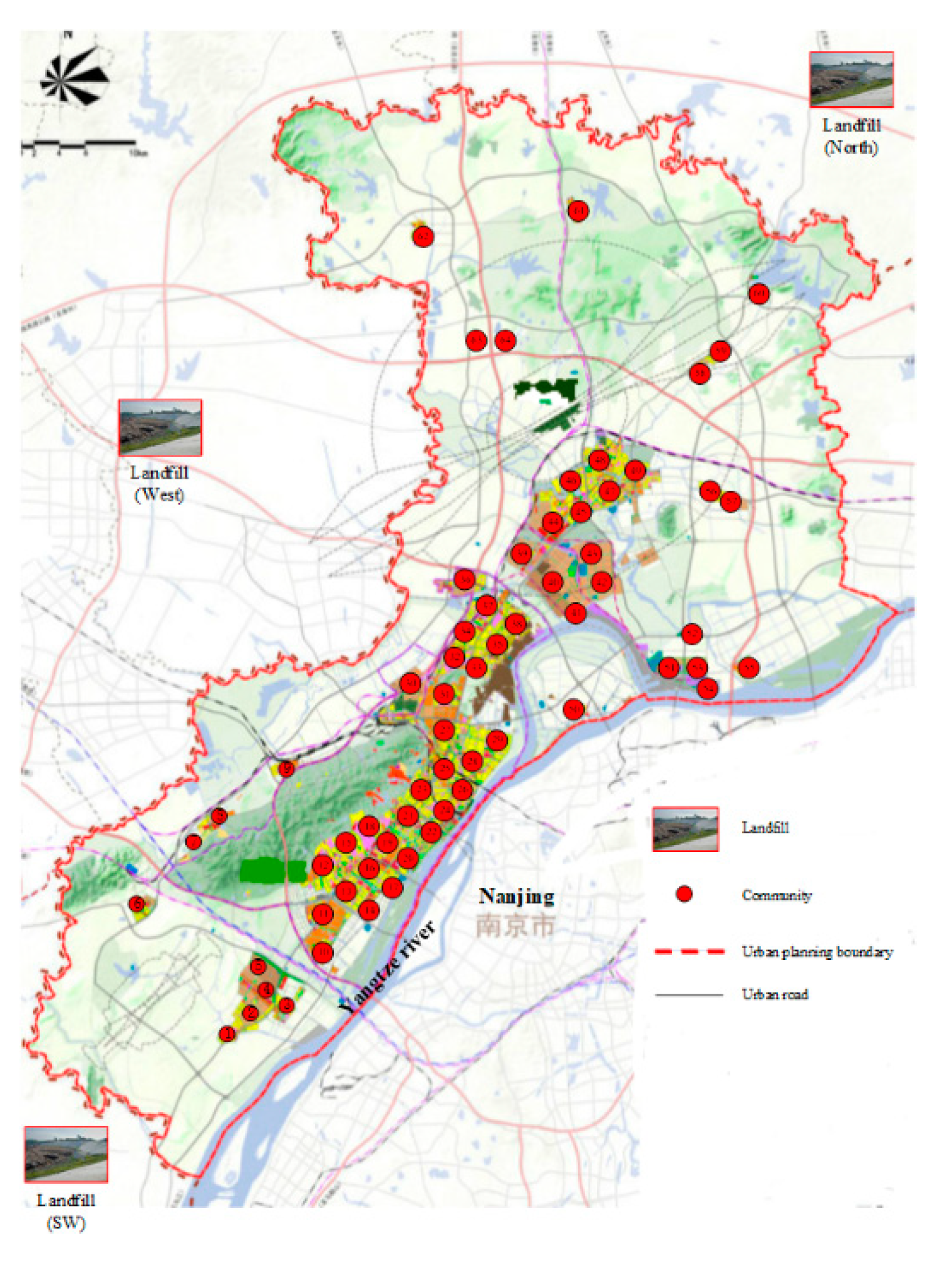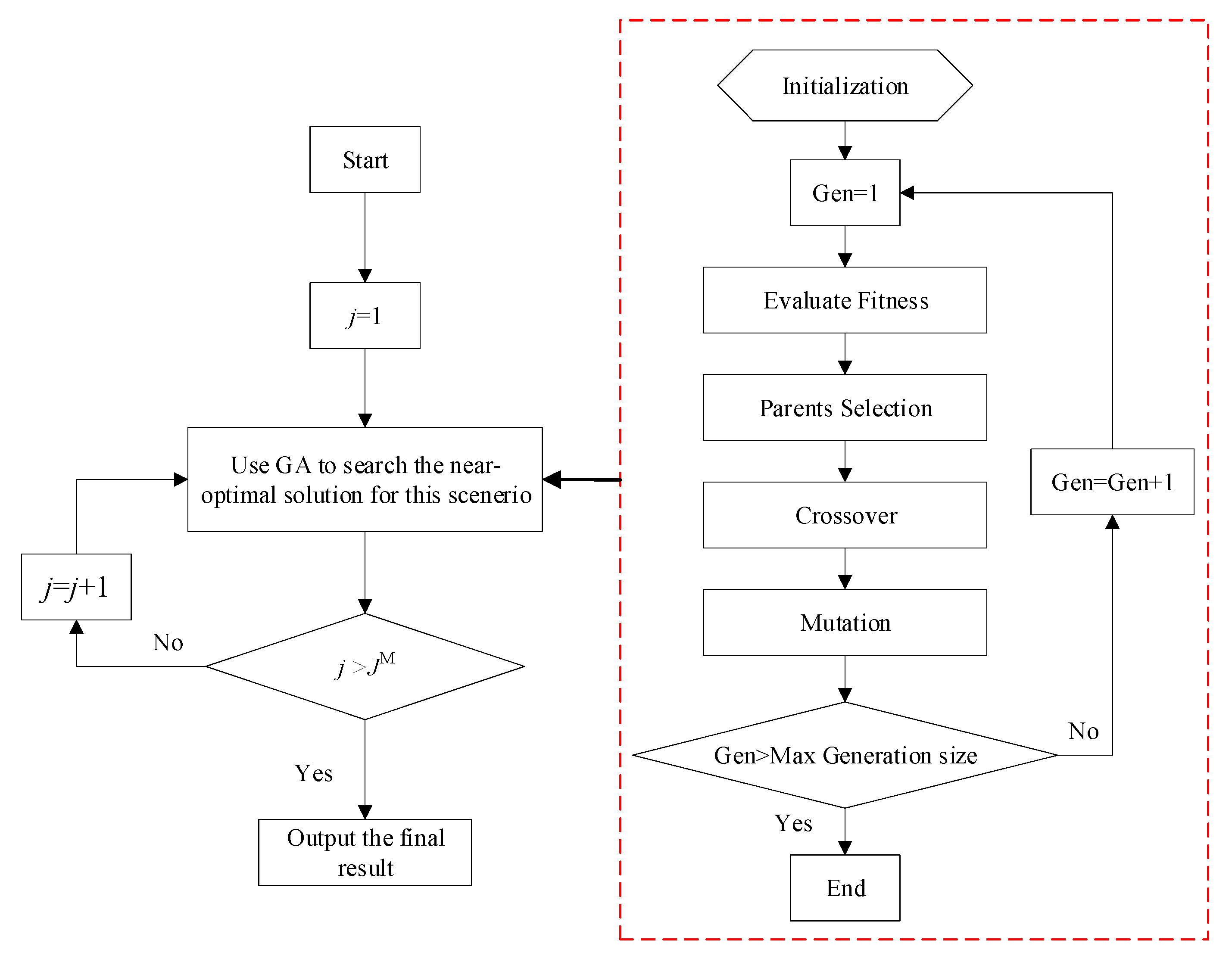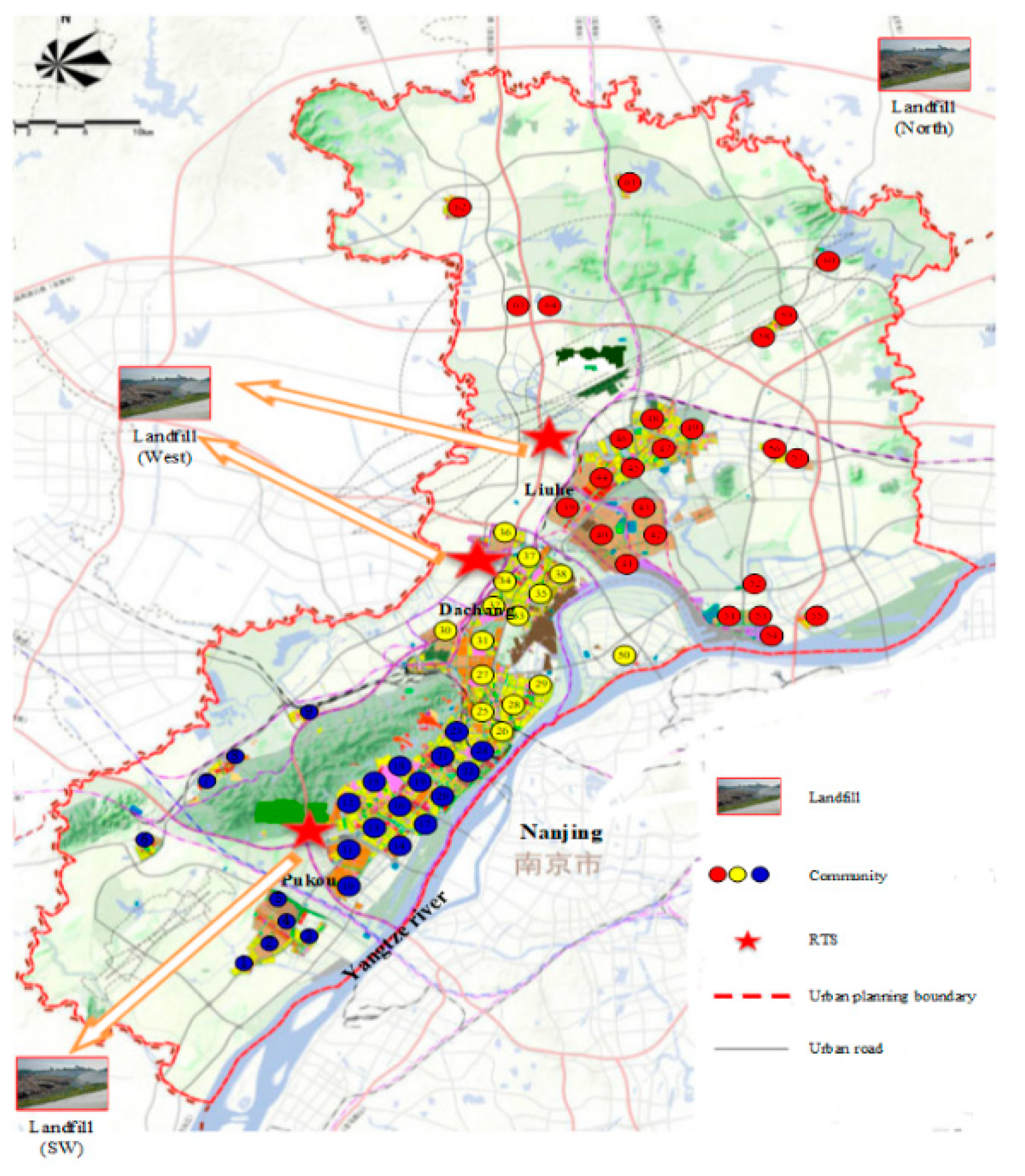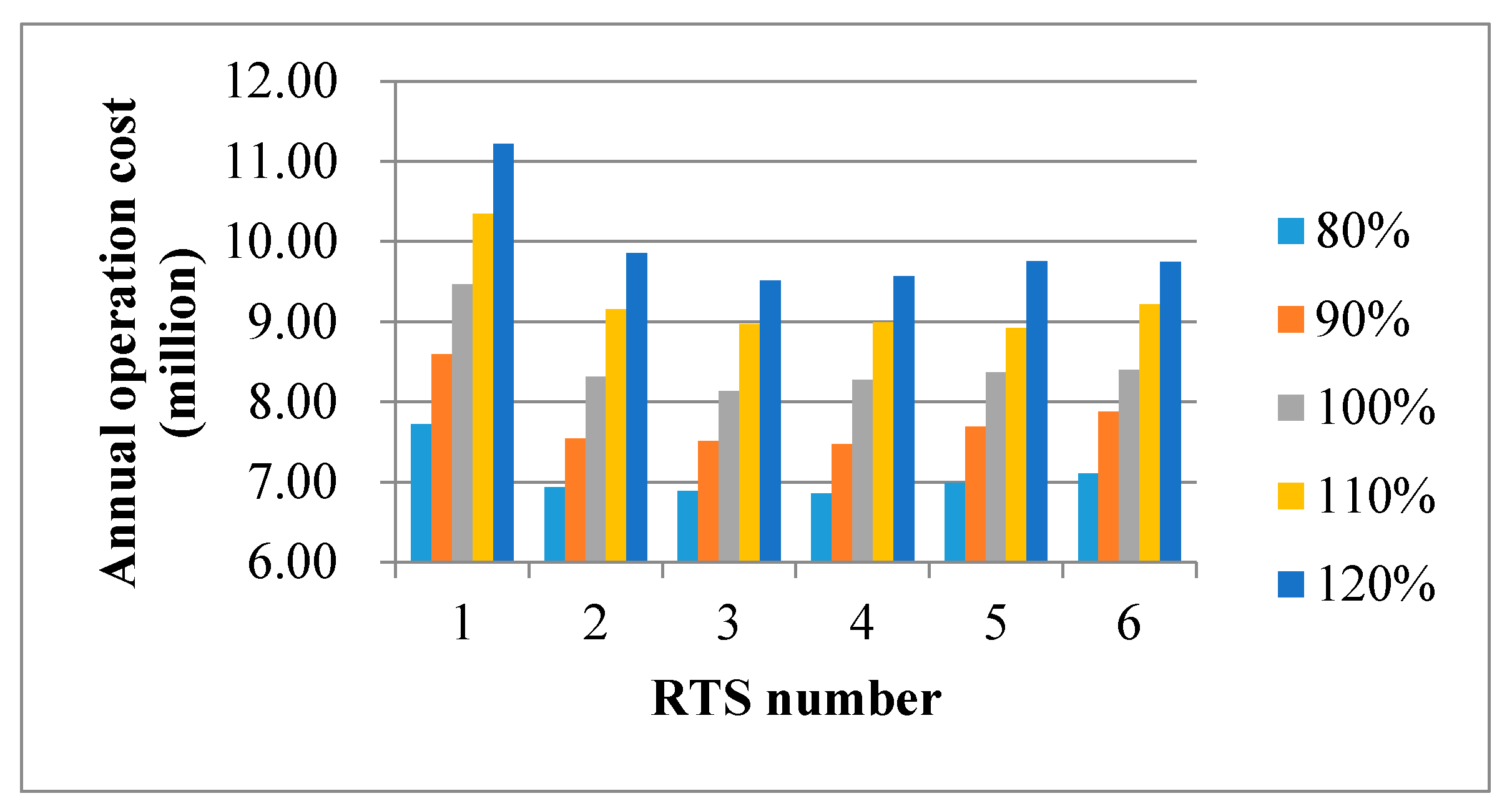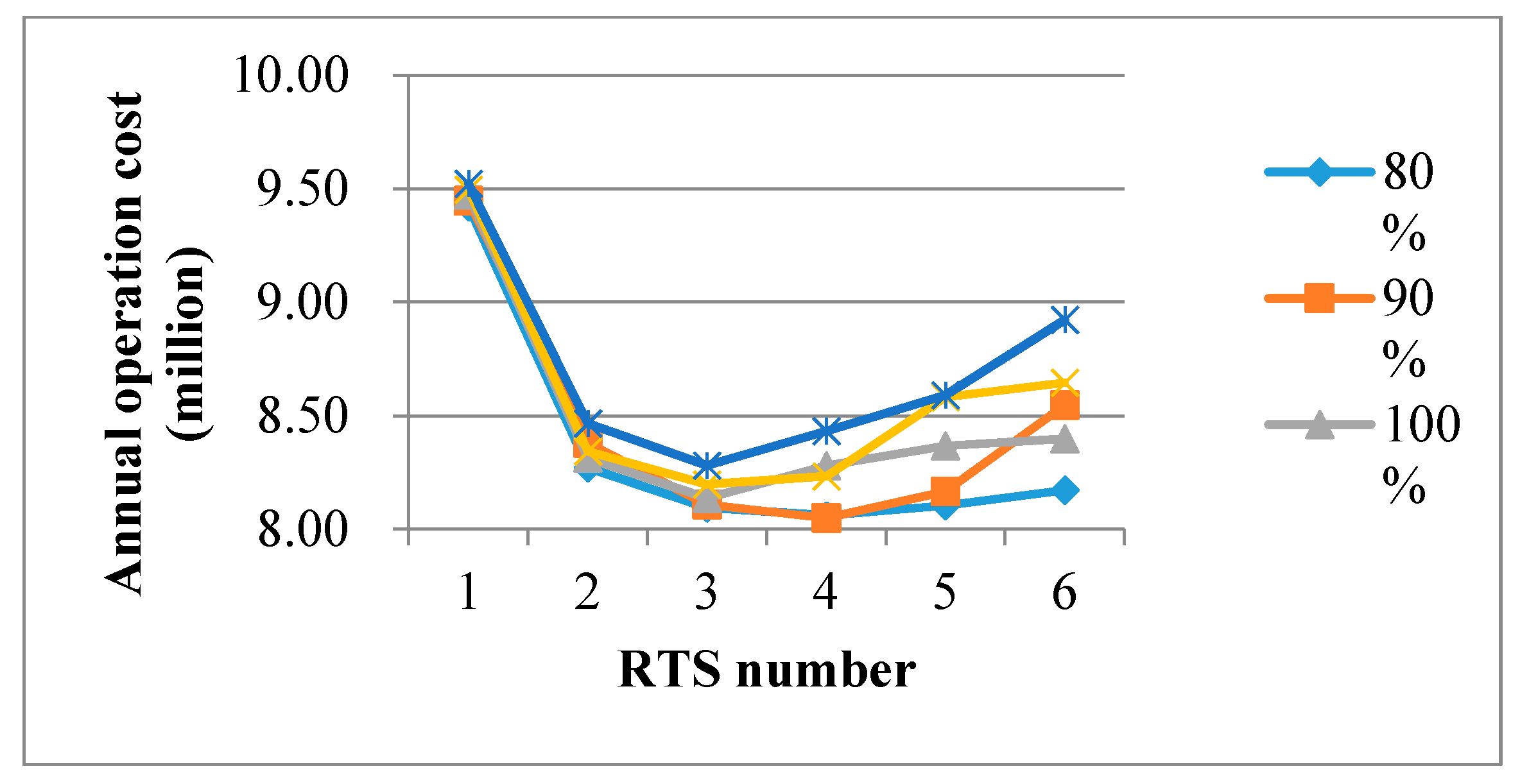1. Introduction
This research was motivated by the practical concern of municipal solid waste (MSW) collection operations in the Nanjing Jiangbei new area. The new area, established on 27 June 2015, is located in the north of the Yangtze River in Nanjing and includes the districts of Pukou, Dachang, Liuhe, and Baguazhou Street of Qixia District. It is the cross point of the Yangtze River economic zone and the eastern coastal economic zone. Along with the rapid urbanization and the increasing population in the past three years, more and more garbage needs to be addressed. Nowadays, how to collect and dispose of the increasing amounts of MSW has become an urgent problem. This concern provides a good chance to use the operational research (OR) method to help local managers address the problem.
To investigate the existing approaches regarding MSW collection, we searched the related literature from multiple channels including Web of Science, Elseviser, and Google Scholar. We used keywords such as ‘solid waste collection’, ‘location and allocation’, ‘solid waste transfer-station location’ and found more than 100 related studies on this topic. We noticed that although research into MSW collection has been conducted for several years, most of them were published in environmental or scientific journals. Despite its importance and particularity, only a few studies have used the OR method to improve the municipal service level. In what follows, we briefly introduce some of the methods that we believe are most relevant to our study.
First, with the increasing population, the rapid growth of the economy, and the rise in living standards [
1], more and more scholars have noticed the importance of MSW management in city living [
2]. For example, reference [
3] provided several solutions for solid waste management in a rapidly urbanizing area in Thailand. Reference [
4] proposed a method for forecasting MSW generation in a fast-growing urban region with system dynamics modeling. Reference [
5] analyzed some economic factors and political factors in influencing the privatization of MSW collection. Reference [
6] investigated more than thirty cities in 22 developing countries across four continents to find the factors influencing the performance of waste management. Although these scholars pointed out that the capacity design of refuse transfer station (RTS) is an urgent problem because the current sites are seriously overloaded, they focused on the influencing factors regarding waste management, but did not design an optimal network for MSW collection.
Second, early scholars developed several optimization models to guide the location decisions of RTS. For example, Reference [
7] proposed a general mathematical programming approach with four stages to determine the locations of RTSs. Reference [
8] provided an analytical model and a traditional location-allocation model to determine the number, capacities, and locations of RTSs in an urban region. Reference [
9] described the MSW problem as a network flow problem and developed a special purpose algorithm to solve it. Reference [
10] presented a multi-objective optimization model for locating RTSs. The model sought the best tradeoff between minimizing costs and public opposition. Considering the inherent uncertainties in both economic and environmental goals, Reference [
11] proposed a fuzzy goal programming approach to determine the best planning of MSW collection. Although early scholars have proven that resources used for MSW collection can be utilized more effectively if waste is transported to the disposal area via a RTS, the optimization model they used were deterministic and discrete, but not continuous.
Third, in the past five years, the optimization problem of MSW collection has attracted more and more attention due to quick urbanization and population growth. Reference [
12] used an integer programing approach to optimize the route of MSW collection. The route solutions generated by the proposed methodology performed significantly better than the traditional routes that were manually designed. In reference [
13], the vehicle routing problem (VRP) for MSW collection was complicated by inter-arrival time constraints. Reference [
14] proposed a spatial allocation model to improve the MSW collection in Singapore. Reference [
15] formulated MSW collection as a vehicle routing model within time windows, and applied their model in Danang City, Vietnam. Reference [
16] proposed a bi-objective mixed integer optimization model to determine the locations of landfills and RTSs simultaneously, where one objective was the usual cost minimization, while the other minimized pollution. Unlike traditional approaches that always focus on RTS location, reference [
17] surveyed the landfill location models that have appeared in the literature during the last forty years. In particular, reference [
18] reported on a related literature review regarding operations research in MSW collection. Note that the majority of existing approaches have preferred to explore the VRP in MSW collection in recent years. Such an operation is tactical decision-making while network design for MSW collection is strategic decision-making. We also note that several existing approaches characterize MSW collection problem as a multi-source Weber problem (MWP) [
16] or set cover problem (SCP) [
13] on a continuous space. As is widely known, the number of new facilities to be opened is known in advance in a MWP and it is totally undetermined in a SCP. Unlike these two extremes, we preset a maximum number of RTSs that could be constructed in this paper. We tested all the possible scenarios and then determined the optimal number of RTS. Therefore, our model can be addressed as a middle state between the above two extremes.
Regarding the solution algorithm, reference [
19] provided a heuristic approach combined with life cycle assessment to optimize MSW collection in Peru. Reference [
20] presented a dynamic location analysis method to determine the optimal MSW collection strategy. Reference [
21] designed the location-allocation problem for waste management by using the genetic algorithm (GA). Reference [
22] used a Tabu search algorithm to design the optimal network for MSW collection. In particular, Reference [
23] proposed three heuristics (GA, simulated annealing, and relocation search) to solve a location-allocation problem on a continuous space. The results demonstrated that no single algorithm dominated another. In other words, the three heuristics were well-matched. The above studies demonstrate that several algorithms are available to solve the optimization model for MSW collection.
In this paper, we conducted a MSW collection in the Nanjing Jiangbei new area.
Figure 1 shows that people in this new area are mainly concentrated in 64 communities including residential areas, commercial institutions, schools, colleges, industrial firms, and so on. There are three landfills, which are respectively located at the southwest, west, and north boundaries of Nanjing. The core questions in designing the MSW collection network includes: (1) how many refuse transfer stations (RTSs) should be constructed; (2) where to locate them; (3) what is the relative capacity of each RTS; (4) how to allocate the 64 communities to these RTSs; and (5) what is the annual operation cost and service level for the optimal scenario as well as other scenarios.
The above problems (1), (2), and (4) are commonly addressed in location-allocation problems. Generally, location and allocation for multiple facilities on a continuous space rests on the multi-source Weber problem (MWP), where the number of new facilities to be opened is known in advance. However, determining the number of RTSs is one of the main questions that need to be answered in the Nanjing Jiangbei new area. Therefore, our model needed to simultaneously decide how many RTSs should be opened and where to locate them. More important, we defined a relative size for each RTS and considered the optimal capacity setting for each of them (Question (3)). We tested the annual operation cost and service level for all possible scenarios, and finally determined the optimal scenario (Question (5)). The above two works make our paper different from the existing approaches, which have always preset several constraints for the RTS.
The rest of this paper is organized as follows. We provide details of the model formulation in
Section 2.
Section 3 designs an algorithm to effectively solve the optimization model. In
Section 4, we apply the model to the Nanjing Jiangbei new area and provide a sensitivity analysis to examine the impact of changes in the model parameters on the optimality of the proposed model. Finally, our conclusions and suggestions for future research are presented in
Section 5.
2. Model Formulation
2.1. Definition for the Relative Parameters
2.1.1. Distance
In most location-allocation problems, distance is an indispensable variable because the core of optimization pursues that the sum of distance from the facility to the customers is minimized. Among the many measures proposed to determine the proximity between two points on a plane, the Euclidean distance is the simplest and easiest to implement [
23]. For a RTS at
and a community
at
, the Euclidean distance is computed as follows:
The Euclidean distance between the landfill and the RTS can be similarly calculated. Note that we did not know how many RTSs should be constructed, and we did not have any potential locations for them in advance. In other words, the continuous map of the Nanjing Jiangbei new area provides infinite possibilities for the coordinates of each RTS.
2.1.2. Unit Transportation Cost
In practice, there are two commonly used shipping methods: the full-truckload (TL) and less-than-truckload (LTL). By TL, we refer to the shipment of a full truckload of solid waste, and by LTL, we refer to shipments with a relatively small freight that do not fill the truck. According to our survey, the local government uses the TL mode to ship the processed solid waste from the RTSs to the landfills to ensure efficiency, and use the LTL mode to ship from the communities to the RTSs to satisfy the variable demand in different communities. Generally, the unit transportation cost is calculated on the basis of kilometers and the weight of the shipment. The price is expressed in terms of load distances, such as ton-kilometer, where a ton-kilometer is the amount of transportation activity to move a ton of solid waste over a distance of one kilometer. With regard to the speed, truck drivers are expected to transport freight at an average rate of 30 km per hour all the way to the destination.
2.1.3. Demand Forecasting in the Communities
Assume that
is the number of people who live in community
.
is the daily output of solid waste for each person. Generally, it falls in the range of (0.8, 1.2) kilograms.
is a coefficient to reflect the variation in consumption level. Let
be the average amount of solid waste needed to be transported in community
per day, and it can be formulated as follows:
2.1.4. Relative Size of the RTS and its Operating Cost
Let
be the average amount of solid waste shipped from community
to RTS
per day.
is the average amount of solid waste transshipped in RTS
per day.
is the relative size of RTS
, and reflects the proportion of solid waste that will be processed at such a RTS [
23]. Then, we have the following Equations (3) and (4):
Note that if
equals 1, all solid waste will be transferred through one RTS. The operating cost of the RTS is defined as follows: First, a fixed investment
that is incurred whenever RTS
is enabled. The fixed investment
equals the infrastructure investment of the RTS divided by its expected service time (years). Second, there is a unit variable cost
, which reflects the varying cost to process the solid waste in the RTS. Let
be a binary variable that takes the value of 1 if RTS
is opened, then the annual (365 days) operating cost for RTS
can be defined as follows:
Note that the linear function implies the economies of scale when RTS is opened. For example, if , , and , then the annual operating cost is $101,825 (100,000 + 365 × 0.5 × 10) if RTS processes 10 tons of solid waste daily. The unit turnover cost is $27.9 (101,825/3650). However, if 100 tons of solid waste is processed per day in this RTS, the annual operating cost will be $118,250 and the unit turnover cost will be decreased to $3.24 (118,250/36,500). If we combine the total transportation cost with the annual operating cost, the annual operation cost for solid waste collection can be derived.
2.2. The Optimization Model
In this subsection, we describe the optimization model for MSW collection in the Nanjing Jiangbei new area. We focused on the decisions of location and allocation of the RTS. To facilitate model formulation in the following context, we provide all notations as follows:
Indexes
: Set of communities in the Nanjing Jiangbei new area, .
: Set of RTSs, . As mentioned above, since we did not know the optimal number of RTS in advance, we used the symbol to represent the set of possible RTS. In the solution section, we tested all possibilities of this set from one to the maximum number of RTS that could be constructed (). The optimal number of RTS will be equal to or less than the value specified.
: Set of landfills in the Nanjing Jiangbei new area, .
Parameters
: Unit transport cost from community to RTS .
: Unit transport cost from RTS to landfill .
: Coordinates of community .
: Coordinates of landfill .
: Average amount of solid waste per day in community .
Variables
: Coordinates of RTS .
: Distance from RTS to landfill .
: Distance from RTS to community .
: Binary variable that takes one if RTS serves community .
: Binary variable that takes one if RTS is opened.
: Operating cost of RTS .
: Average amount of solid waste transshipped in RTS per day.
: Average amount of solid waste shipped from community to RTS per day.
: Average amount of solid waste shipped from RTS to landfill per day.
According to the above notations, the optimization model for MSW collection in the new area can be formulated as follows:
The proposed model is a mixed integer nonlinear programming model (MINLP). The objective function, Equation (6), minimizes the annual operation costs, which includes the cost of transportation between the communities and the RTSs, the cost of shipping solid waste between the RTSs and the landfills, and the operating cost in these RTSs. Constraint (7) is a single-sourcing constraint that restricts a community’s solid waste to be collected by a single RTS. Constraint (8) is the flow conservation constraint, which ensures that all solid waste will be finally transported to the landfills. Constraint (9) means that the community can only be assigned to the opened RTS. Constraint (10) ensures that solid waste in all communities will be collected. Constraint (11) ensures that and are binary variables. Constraint (12) requires that all flow variables, and , are non-negative integers. Finally, in Constraint (13) take any coordinates in the new area.
The above model simultaneously decides how many RTSs should be opened and where to locate them. Furthermore, it determines the relative size of each RTS and the annual operation costs for different scenarios. Note that our model is an extension of MWP and thus is a nondeterministic polynomial-time hard (NP-hard) problem. The main difficulty in solving NP-hard problems arise because the objective function is not convex and has a large number of local minima. Therefore, we need to design an effective algorithm to solve the proposed model.
5. Conclusions
In this paper, we proposed a MINLP model for designing the MSW collection network in the Nanjing Jiangbei new area. The model simultaneously decided the optimal number of RTSs, identified the appropriate site for each RTS, determined the relative size of each RTS, allocated each community to a specific RTS, and determined the annual operation cost and service level for the optimal scenario as well as other scenarios. The main contributions of this study are summarized below.
First, our optimization model determined the optimal number of RTSs. This model was different to the classic MWP where the number of new facilities to be opened is known in advance. Our model is also different to the classic SCP where the number of new facilities to be opened is totally undetermined. As mentioned in
Section 1, our model can be seen as a middle state between the above two extremes. In this study, although we did not preset the number of RTSs, we set a maximum number limitation of RTS. Then, we tested all possible scenarios and finally determined the optimal number of RTSs. These results are significant because it helps to identify the annual operation cost and service level for the optimal scenario as well as other scenarios.
Second, our model simultaneously determined the relative size of each RTS. Note that the relative size of a RTS is proportional to the total amount of solid waste assigned to that specific station, and the operating cost of such a RTS is also related to its relative size. Combined with the first conclusion, we used the optimal result to guide managers to make decisions of how many RTSs should be constructed, where they should be located, and the optimal capacity for each of them. To the best of our knowledge, our method is different from most existing approaches that always preset the capacity of RTS or provide some potential points as the candidate alternatives when modeling the problem.
As for the limitations of this study, we used Euclidean distance to calculate the distance between two points on the planning area. This may alleviate the optimality of the optimal result when applied in practice. Second, the forecasting model for solid waste produced was rather simplified. This may provide an inaccurate forecast at the demand points and thus influence the final network design. Moreover, we used GA in this study to solve the optimization model. This may give an approximate optimal solution within a reasonable amount of time, but not a real optimal result.
Future research can be extended and enhanced in the following directions. Initially, the parameter setting in this study is relatively simple. Further measurements regarding particular parameters need to be conducted to improve the accuracy of the estimated data. Second, we only considered the relationship between the communities, the RTSs, and the landfills in this study. Other recycling infrastructures and processes were not within the scope of this paper. Finally, factors such as environmental emission regulations can be combined into the model, which can help to improve the accurate application of the mathematical model.
